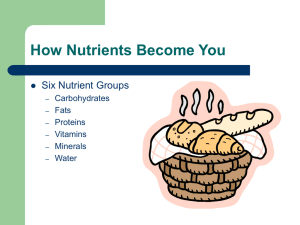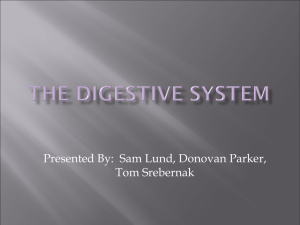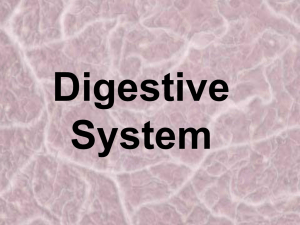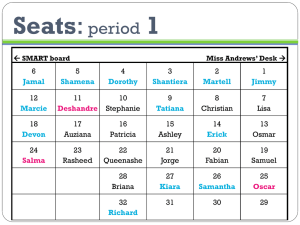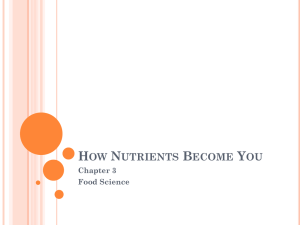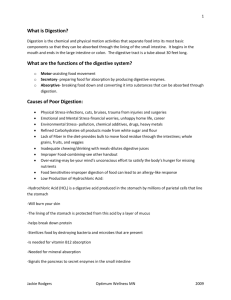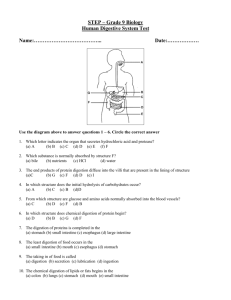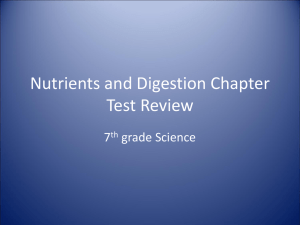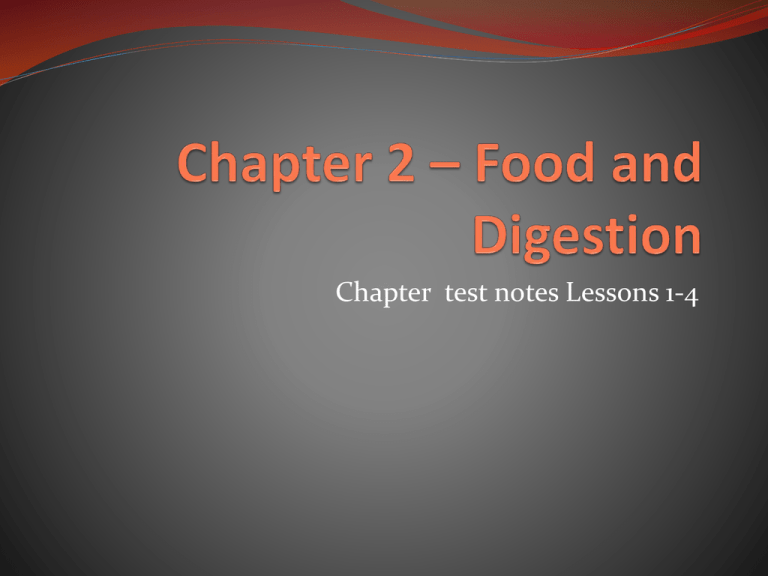
Chapter test notes Lessons 1-4
Why you need Food
Food provides your body with materials for growing and for
repairing tissues. Food also provides energy for everything
you do,
Your body breaks down the foods you eat into nutrients.
Which are substances in food that provides the raw
materials and energy the body needs to carry out all
essential processes.
When nutrients are used by the body for energy, the
amount of energy they release can be measured in a unit
called calorie. One calorie is the amount of energy needed
to raise the temperature of one gram of water by one degree
Celsius.
You need to eat a certain amount of Calories each day
to meet your body’s energy needs.
In addition to providing energy, carbohydrates provide
the raw materials to make cell parts.
Simple carbohydrates are also known as sugars. One
sugar, glucose is the major source of energy for your
body’s cells.
Complex carbohydrates are made up of many sugars
molecules linked together in a chain. Starch is a
complex carbohydrate found in foods from plants,
such as potatoes, rice, wheat, and corn.
Fats
In addition to providing energy, fats have other
important functions. Fats form part of the cell
membrane, the structure that forms the boundary of a
cell. Fatty tissue protects and supports your internal
organs and insulates your body.
Fats can be classified as unsaturated or saturated
based on their chemical structure.
Cholesterol is a waxy, fatlike substance found only in
animal products.
Proteins
Proteins are needed for tissue growth and repair. They
also play an important part in chemical reactions with
cells.
Proteins are made up of small units called amino acids.
Animal products such as meats and eggs contain
complete proteins. Incomplete proteins are found in
beans, nuts, and grains.
Vitamins and Minerals
Vitamins act as helper molecules in a variety of
chemical reactions in the body.
Fresh vegetables are full of vitamins.
Both fat-soluble vitamins and water-soluble vitamins
are necessary to maintain health.
Both vitamins and minerals are needed by your body
in small amounts to carry out chemical processes.
Water
Water is the most important nutrients because the
body’s vital processes – including chemical reactions
such as the breakdown of nutrients – take place in
water.
Lesson 2 – Healthy Eating
The USDA guidelines provide a personalized way to
help people make healthy food choice based on their
age, sex, and amount of physical activity.
A food pyramid can help you plan healthy meals.
Food Labels
Food labels allow you to evaluate a single food as well
as to compare the nutritional value of two different
foods.
Food Labels tell you :
Serving Size
Calories
Percent Daily Value
Ingredients
Food labels can help you make healthy food choices.
Food labels also help you monitor the nutrients in your
diet.
Guidelines that show the amounts of nutrients that are
needed everyday are known as the Dietary Reference
Intakes (DRIs)
DRIs also show how the calories that people eat each
day should be split among carbohydrates, fats and
proteins.
Lesson 3 – The digestive Process
Begins
The digestive system has three main functions:
Break down food into molecules that the body can use.
Than, the molecules are absorbed into the blood and
carried throughout the body.
Finally, wastes are eliminated from the body.
Digestion
The process by which your body breaks down food into
small nutrients molecules is called digestion.
There are two kinds of digestion – mechanical and
chemical.
In mechanical digestion, foods are physically broken
down into smaller pieces. Example: biting and
chewing
In chemical digestions, chemicals produces by the
body break foods into smaller chemical building
blocks.
Absorption and Elimination
After your food is digested, the molecules are ready to
be transported throughout your body.
Absorption is the process by which nutrient molecules
pass through the wall of your digestive systems into
your blood.
Materials that are not absorbed are eliminated from
the body as waste.
The Mouth
Both mechanical and chemical digestion begin in the
mouth. The fluid released when your mouth waters is
known as saliva. Saliva plays an important role in both
kinds of digestion.
Mechanical digestion begins in the mouth, where the
teeth cut and tear food into smaller pieces. Salivary
glands release enzymes that begin chemical digestion.
The Esophagus
There are two openings located at the back of your mouth:
your windpipe and esophagus.
Your windpipe carries air into your lungs
Your food, goes into your esophagus which is a muscular
tube that connects your mouth to your stomach.
The epiglottis is a small flap of tissue that seals off your
windpipe, preventing food from entering.
Food remains in the esophagus for only about 10 seconds. It
is the contracted down towards your stomach with the
smooth muscles that make up your esophagus. This muscle
contraction is known as peristalsis.
The Stomach
Most mechanical digestion and some chemical digestion occurs
in the stomach.
The process of mechanical digestion occurs as three strong layers
of smooth muscles contract to produce a churning motion.
Chemical digestion occurs as the churning food makes contact
with digestive juice, a fluid produced by cells in the lining of the
stomach.
Digestive juice contains the enzyme pepsin – which chemically
digests proteins in your food, breaking them down into short
chains of amino acids.
Digestive juice also contains hydrochloric acid, a very strong
acid. Without this acid your stomach could not function
properly.
Food remains in the stomach until all off the solid
material has been broken down into liquid form. A few
hours later, the stomach completes mechanical
digestion and moves onto the next part of your
digestive tract.
Lesson 4 – Final Digestion and
Absorption
The Small Intestine & Liver
After the thick liquid leaves the stomach, it enters the
small intestine. The small intestine is the part of the
digestive system where mot chemical digestion takes
place.
Almost all chemical digestions and absorption of
nutrients takes place in the small intestine.
The liver is located in the upper right portion of the
abdomen and is the largest organ inside the body.
The role of the liver in the digestive system is to
produce bile. Bile is a substance that breaks up fat
particles and flows into the gallbladder.
The Gallbladder & Pancreas
The gallbladder is an organ that stores bile. Bile is not
an enzyme and does not chemically break up food. It
does however, physically break up large fat particles
into smaller fat droplets.
The pancreas is a triangular organ that lies between
the stomach and the first part of the small intestine.
As part of the digestive system, the pancreas produces
enzymes that flow into the small intestine and help
break down starches, proteins, and fats.
The Large Intestine
The remaining materials move from the small
intestine into the large intestine. The large intestine is
the last section of the digestive system.
The material entering the large intestine contains
water and undigested food. As the materials move
through the large intestine, water is absorbed into the
bloodstream. The remaining material is readied for
elimination from the body.


